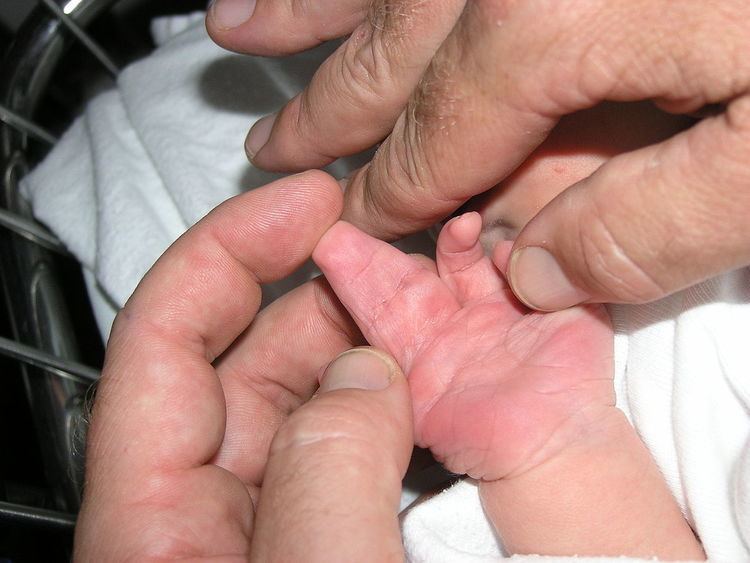Specialty medical genetics ICD-9-CM 755.1 MedlinePlus 003289 | ICD-10 Q70 DiseasesDB 29330 | |
 | ||
OMIM 185900 186100 186200 186300 | ||
Syndactyly (from Greek συν- meaning "together" and δακτυλος meaning "finger") is a condition wherein two or more digits are fused together. It occurs normally in some mammals, such as the siamang and diprotodontia, but is an unusual condition in humans.
Contents
Classification
Syndactyly can be simple or complex.
Syndactyly can be complete or incomplete.
Complex syndactyly occurs as part of a syndrome (such as Apert syndrome) and typically involves more digits than simple syndactyly.
Fenestrated syndactyly means the skin is joined for most of the digit but in a proximal area there is gap in the syndactyly with normal skin. This type of syndactyly is found in amniotic band syndrome.
Simple syndactyly can be full or partial, and is present at birth (congenital). In early human fetal development, webbing (syndactyly) of the toes and fingers is normal. At about 6 weeks of gestation, apoptosis takes place due to a protein named sonic hedgehog, also known as SHH, which dissolves the tissue between the fingers and toes, and the webbing disappears. In some fetuses, this process does not occur completely between all fingers or toes and some residual webbing remains.
Genetics
Five types of syndactyly have been identified in humans. The corresponding loci associated with these types and their common phenotypical expression are as follows:
Timing
Syndactyly of the border digits (thumb/index finger or ring/small fingers) is treated at early age to prevent the larger digit from curving towards the smaller digit with growth. Typically, syndactyly of these digits is treated at six months of age. The treatment of syndactyly of the other digits is elective and is more commonly performed when the digits have grown, at 18–24 months of age.
Techniques
Because the circumference of the conjoined fingers is smaller than the circumference of the two separated fingers, there is not enough skin to cover both digits once they are separated at the time of surgery. Therefore, the surgeon must bring new skin into the area at the time of surgery. This is most commonly done with a skin graft (from groin or anterior elbow). Skin can also be used from the back of the hand by mobilizing it (called a "graftless" syndactyly correction), which requires planning over a period of months prior to surgery.
Complications
The most common problem with syndactyly correction is creeping of the skin towards the fingertip over time. This is likely due to tension at the site of the repair between the digits. Additional surgery may be required to correct this. One critique of using skin grafts is that the grafts darken in the years after surgery and become more noticeable. Also, if the skin grafts are harvested from the groin area, the skin may grow hair. Finally, the fingers may deviate after surgery. This is most commonly seen in complex syndactyly (when there has been a bony joining of the fingers).
History
The earliest appreciation of syndactyly as a birth anomaly or burn-trauma can be traced back to the Andalusian Muslim surgeon Al-Zahrawi (d. 1013 CE), known in the West as Abulcasis. Ambroise Paré also described syndactyly in the sixteenth century.
